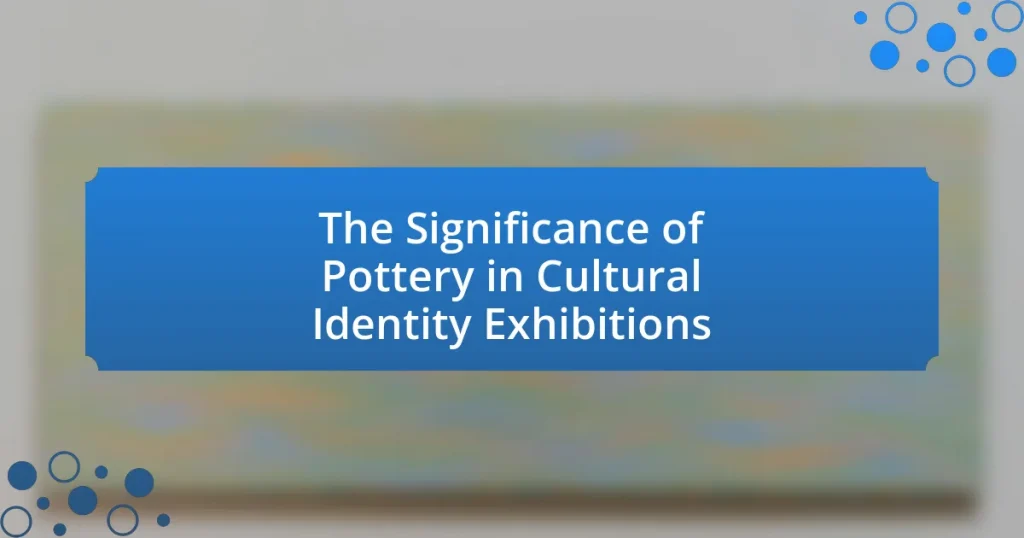Pottery is a crucial element in cultural identity exhibitions, serving as a tangible representation of a community’s heritage and traditions. The craftsmanship involved in pottery reflects unique cultural techniques, materials, and aesthetic values, preserving and transmitting cultural narratives. This article explores how pottery embodies cultural identity through its forms, decorations, and traditional techniques, while also examining its role in enhancing community cohesion and preserving cultural history. Additionally, it addresses the challenges faced by exhibitions, including authenticity and representation issues, and highlights emerging trends such as sustainability and digital integration in showcasing pottery.

What is the significance of pottery in cultural identity exhibitions?
Pottery holds significant importance in cultural identity exhibitions as it serves as a tangible representation of a community’s heritage and traditions. The craftsmanship involved in pottery reflects the unique techniques, materials, and aesthetic values of a culture, allowing for the preservation and transmission of cultural narratives. For instance, indigenous pottery often incorporates symbols and designs that convey historical stories and spiritual beliefs, making it a vital medium for cultural expression. Furthermore, studies have shown that pottery can enhance community cohesion by fostering a sense of pride and belonging among individuals, as it connects them to their ancestral roots and collective identity.
How does pottery reflect cultural identity?
Pottery reflects cultural identity by embodying the traditions, values, and aesthetics of a specific community. Each pottery style, technique, and decoration often signifies the historical context and social practices of the culture it originates from. For example, Native American pottery features distinct designs and materials that convey spiritual beliefs and communal narratives, while Japanese ceramics emphasize harmony with nature, reflecting Zen philosophies. The use of local resources and traditional methods in pottery-making further reinforces a community’s connection to its environment and heritage, showcasing the unique identity of that culture through tangible artifacts.
What elements of pottery convey cultural narratives?
Elements of pottery that convey cultural narratives include form, decoration, materials, and techniques. The shape of pottery can reflect functional purposes and aesthetic preferences unique to a culture, while decorative motifs often symbolize historical events, beliefs, or social structures. For instance, Native American pottery frequently features designs that represent nature and spirituality, illustrating the connection between the community and its environment. The materials used, such as clay types and glazes, can indicate regional resources and technological advancements, further embedding cultural identity. Techniques, including hand-building or wheel-throwing, reveal traditional practices passed down through generations, showcasing the craftsmanship and values of a culture. These elements collectively serve as a visual language, communicating stories and identities across time and space.
How do traditional techniques influence cultural representation in pottery?
Traditional techniques significantly influence cultural representation in pottery by embedding historical practices, symbols, and community narratives into the ceramic art form. These techniques, such as hand-building, coiling, and specific glazing methods, reflect the unique cultural heritage and identity of the potters’ communities. For instance, the use of indigenous clay and traditional firing methods can showcase the environmental context and ancestral knowledge, which are vital to the cultural identity of a region. Additionally, patterns and motifs used in pottery often carry specific meanings tied to cultural stories or rituals, reinforcing the connection between the art and the community’s values. This relationship is evident in various cultures, such as the Pueblo pottery of the American Southwest, where traditional methods and designs are integral to their cultural expression and identity.
Why is pottery considered a vital aspect of cultural heritage?
Pottery is considered a vital aspect of cultural heritage because it embodies the artistic expression, historical practices, and social values of a community. Throughout history, pottery has served as a medium for storytelling, reflecting the identity and traditions of various cultures. For instance, archaeological findings show that pottery styles can indicate trade routes and cultural exchanges, revealing insights into the lives of ancient civilizations. Additionally, UNESCO recognizes traditional pottery techniques as intangible cultural heritage, emphasizing their role in preserving cultural diversity and fostering community identity.
What role does pottery play in preserving cultural history?
Pottery plays a crucial role in preserving cultural history by serving as a tangible representation of the artistic, social, and technological practices of a community. Through the study of pottery styles, materials, and techniques, researchers can gain insights into the daily lives, beliefs, and interactions of past societies. For example, archaeological findings of pottery in ancient civilizations, such as the intricate designs of Mesoamerican ceramics, reveal information about trade networks, social hierarchies, and cultural rituals. This evidence underscores pottery’s significance as a medium for understanding and documenting cultural heritage across generations.
How does pottery contribute to community identity and cohesion?
Pottery contributes to community identity and cohesion by serving as a tangible representation of cultural heritage and shared values. Through the creation and use of pottery, communities express their unique traditions, techniques, and artistic styles, which fosters a sense of belonging among members. For instance, specific pottery styles can be linked to particular regions or ethnic groups, reinforcing local identity. Additionally, communal pottery-making events encourage collaboration and interaction, strengthening social bonds. Research indicates that communities engaged in traditional crafts, such as pottery, report higher levels of social cohesion and cultural pride, as evidenced by studies conducted by the University of Exeter, which highlight the role of craft in community engagement and identity formation.

How are pottery exhibitions designed to showcase cultural identity?
Pottery exhibitions are designed to showcase cultural identity by highlighting the unique styles, techniques, and materials that reflect the heritage of specific communities. These exhibitions often feature traditional pottery forms that are emblematic of cultural practices, such as specific glazing techniques or motifs that tell stories of the community’s history and values. For instance, the use of indigenous clay and traditional firing methods can illustrate a connection to ancestral practices, reinforcing the cultural narrative. Additionally, curators may organize pottery pieces thematically, grouping them by cultural significance or historical context, which allows visitors to understand the relationship between the pottery and the identity of the culture it represents. This approach not only educates the audience about the cultural significance of the pottery but also fosters appreciation for the craftsmanship and the stories behind each piece.
What are the key components of a pottery exhibition?
The key components of a pottery exhibition include the selection of pottery pieces, display arrangements, educational materials, and interactive elements. The selection of pottery pieces showcases various styles, techniques, and cultural significance, often representing different historical periods or geographic regions. Display arrangements are crucial for visual appeal and accessibility, allowing visitors to appreciate the craftsmanship and details of each piece. Educational materials, such as labels and brochures, provide context and information about the pottery’s cultural background and artistic techniques. Interactive elements, like workshops or demonstrations, engage visitors and enhance their understanding of pottery-making processes. These components collectively contribute to a comprehensive experience that highlights the cultural identity represented through pottery.
How do curatorial choices impact the representation of cultural identity?
Curatorial choices significantly impact the representation of cultural identity by determining which artifacts are displayed, how they are contextualized, and the narratives that are constructed around them. For instance, in exhibitions focused on pottery, curators may choose to highlight specific cultural techniques or historical contexts, thereby shaping visitors’ understanding of that culture’s identity. Research by the American Alliance of Museums indicates that curatorial decisions influence audience perceptions and can either reinforce stereotypes or promote a more nuanced understanding of cultural diversity. By selecting certain pieces over others and framing them within particular narratives, curators play a crucial role in either validating or challenging existing cultural identities.
What types of pottery are typically featured in cultural exhibitions?
Cultural exhibitions typically feature traditional pottery, contemporary ceramics, functional ware, decorative pieces, and historical artifacts. Traditional pottery often represents the cultural heritage of specific communities, showcasing techniques and designs passed down through generations. Contemporary ceramics highlight modern artistic expressions and innovations in pottery-making. Functional ware includes everyday items like bowls and plates, reflecting the practical aspects of pottery in daily life. Decorative pieces serve aesthetic purposes and often embody cultural symbols or motifs. Historical artifacts provide insight into the evolution of pottery styles and techniques over time, illustrating the significance of pottery in cultural identity.
How do audiences engage with pottery in cultural exhibitions?
Audiences engage with pottery in cultural exhibitions through interactive experiences, educational programs, and emotional connections to cultural heritage. These engagements often include hands-on workshops where participants can create their own pottery, allowing them to connect personally with the craft. Additionally, exhibitions frequently feature guided tours and informational displays that explain the historical and cultural significance of pottery, enhancing understanding and appreciation. Research indicates that such interactive elements increase visitor satisfaction and retention of information, as seen in studies conducted by the American Alliance of Museums, which highlight the importance of active participation in learning environments.
What methods are used to educate visitors about the significance of pottery?
Interactive workshops are commonly used to educate visitors about the significance of pottery. These workshops allow participants to engage hands-on with pottery-making techniques, fostering a deeper understanding of the cultural and historical contexts of pottery. Additionally, guided tours often include informative discussions that highlight the role of pottery in various cultures, showcasing artifacts and their stories. Educational panels and multimedia presentations further enhance visitor knowledge by providing visual and textual information about the evolution of pottery and its significance in cultural identity. These methods collectively create an immersive learning experience that emphasizes the importance of pottery in cultural heritage.
How does interactive display enhance the understanding of cultural identity through pottery?
Interactive displays enhance the understanding of cultural identity through pottery by allowing users to engage with artifacts in a dynamic manner, facilitating deeper connections to the cultural narratives they represent. For instance, interactive exhibits can provide contextual information about the origins, techniques, and cultural significance of specific pottery pieces, enabling visitors to explore the stories behind the craftsmanship. Research indicates that hands-on experiences, such as virtual reality simulations or touch-screen interfaces, significantly improve retention and comprehension of cultural information, as evidenced by studies conducted in museum settings that show increased visitor engagement and learning outcomes.

What challenges do cultural identity exhibitions face regarding pottery?
Cultural identity exhibitions face several challenges regarding pottery, primarily related to authenticity, representation, and preservation. Authenticity issues arise when curators struggle to ensure that the pottery displayed accurately reflects the cultural practices and historical contexts of the communities they represent. For instance, misrepresentation can occur if contemporary artists’ works are presented as traditional artifacts, leading to a distorted understanding of cultural heritage. Representation challenges include the difficulty of showcasing diverse pottery styles from various cultures without favoring one over another, which can result in a lack of inclusivity. Preservation challenges stem from the fragility of pottery, as many pieces are susceptible to damage during transportation and display, necessitating careful handling and climate control to maintain their integrity. These challenges highlight the complexities involved in effectively conveying cultural identity through pottery in exhibitions.
How do cultural appropriation issues affect pottery exhibitions?
Cultural appropriation issues significantly affect pottery exhibitions by influencing the representation and authenticity of cultural artifacts. When artists or institutions display pottery that originates from marginalized cultures without proper context or acknowledgment, it can lead to misrepresentation and commodification of those cultures. For instance, the backlash against exhibitions that feature Native American pottery created by non-Native artists highlights the importance of cultural sensitivity and the need for authentic representation. This dynamic can result in protests, calls for boycotts, and a reevaluation of curatorial practices, as seen in various art institutions that have faced scrutiny for their handling of culturally significant works.
What strategies can be implemented to address cultural sensitivity in exhibitions?
To address cultural sensitivity in exhibitions, curators should implement strategies such as engaging with community representatives, conducting thorough research on cultural contexts, and providing educational resources. Engaging with community representatives ensures that the perspectives and values of the culture being represented are accurately reflected, fostering authenticity and respect. Conducting thorough research on cultural contexts allows curators to understand the significance of artifacts, such as pottery, within their cultural narratives, preventing misrepresentation. Providing educational resources, including interpretive materials that explain cultural practices and meanings, enhances visitor understanding and appreciation, thereby promoting a respectful dialogue around cultural identity. These strategies are supported by best practices in museum studies, which emphasize the importance of collaboration and education in fostering cultural sensitivity.
How can exhibitions balance authenticity and accessibility in pottery displays?
Exhibitions can balance authenticity and accessibility in pottery displays by employing inclusive design strategies that highlight cultural significance while ensuring visitor engagement. Authenticity is maintained through the careful selection of representative pieces that reflect the true craftsmanship and cultural heritage of pottery, such as traditional techniques and materials used by artisans. Accessibility is enhanced by providing clear, informative labels and interactive elements that invite diverse audiences to connect with the exhibits, such as hands-on workshops or digital guides. Research indicates that exhibitions that incorporate both authentic artifacts and accessible educational resources can increase visitor understanding and appreciation, as seen in the Smithsonian’s National Museum of African Art, which successfully integrates cultural context with interactive learning experiences.
What future trends are emerging in pottery and cultural identity exhibitions?
Future trends in pottery and cultural identity exhibitions include a growing emphasis on sustainability, digital integration, and community engagement. Sustainability is becoming a priority as artists and curators focus on eco-friendly materials and practices, reflecting a broader societal shift towards environmental consciousness. Digital integration is also on the rise, with virtual exhibitions and augmented reality experiences enhancing accessibility and engagement for diverse audiences. Additionally, community engagement is increasingly important, as exhibitions aim to involve local artisans and cultural narratives, fostering a deeper connection between the audience and the cultural significance of pottery. These trends are supported by research indicating that exhibitions that prioritize sustainability and community involvement attract larger audiences and foster greater appreciation for cultural heritage.
How is technology influencing the presentation of pottery in exhibitions?
Technology is significantly influencing the presentation of pottery in exhibitions by enhancing interactivity and accessibility for viewers. Digital tools such as augmented reality (AR) and virtual reality (VR) allow visitors to engage with pottery pieces in immersive ways, providing contextual information and historical backgrounds that enrich the viewing experience. For instance, exhibitions can use AR to overlay information about the cultural significance of specific pottery styles, enabling a deeper understanding of their origins and uses. Additionally, 3D scanning and printing technologies enable curators to create replicas of fragile pottery, allowing for broader display options without risking damage to original artifacts. These advancements not only attract a wider audience but also foster a more educational and engaging environment, as evidenced by exhibitions like the “Pottery and Culture” showcase at the British Museum, which utilized these technologies to enhance visitor interaction and learning.
What role does sustainability play in the future of pottery exhibitions?
Sustainability plays a crucial role in the future of pottery exhibitions by promoting environmentally responsible practices and materials. As awareness of environmental issues increases, pottery exhibitions are increasingly incorporating sustainable methods, such as using locally sourced clay and eco-friendly glazes, to minimize their ecological footprint. For instance, a study by the American Craft Council highlights that exhibitions focusing on sustainable practices attract more visitors, reflecting a growing consumer preference for environmentally conscious art. This shift not only enhances the cultural significance of pottery but also aligns with global sustainability goals, making pottery exhibitions more relevant in contemporary discourse.
What best practices can enhance the impact of pottery in cultural identity exhibitions?
Best practices that can enhance the impact of pottery in cultural identity exhibitions include integrating storytelling, utilizing interactive displays, and ensuring cultural authenticity. Storytelling connects visitors emotionally to the pottery, providing context about its cultural significance and history. Interactive displays allow visitors to engage with the pottery, fostering a deeper understanding of the techniques and traditions behind its creation. Cultural authenticity is crucial; showcasing pottery that accurately represents the culture it originates from ensures respect and integrity, which can be supported by research indicating that authentic representations enhance visitor engagement and learning outcomes.


